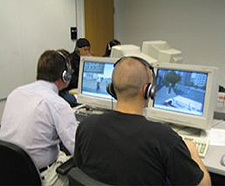Desktop Simulations and Virtual Worlds

Some kinds of simulations do not need fancy visualization or interaction technologies. They can run in a desktop computer using only a screen, a pointing device (a mouse or trackball), and sometimes audio inputs and outputs. A desktop simulator puts all or part of the patient “in the computer.” One can see the patient via animation, drawings, or video. The learner can interact with the patient by asking questions (typing or speaking) or making comments, by viewing data from monitors, labs, or x-rays, and by performing diagnostic or therapeutic actions (typically by making choices with the mouse). Unlike the SP actor, the simulated patient in a desktop simulator doesn’t mind having a serious life-threatening condition, being stuck with needles, or even – should it come to that – dying. The simulated patient can respond to whatever the course of the disease is based on the actions taken.

An even more advanced variant of this approach allows multiple participants to interact simultaneously with the same patient in a common “virtual world,” perhaps linked through the Internet from many different site. The virtual world is typically presented as a 2D perspective world. Each participant has an “avatar” that represents them in the virtual world. You can move your avatar, and when you speak, it speaks. Your avatar can interact with the other participants, who may take on different clinical roles in the clinical world that is created. As in the desktop simulation, information can be gathered, actions taken, and the patient’s condition may improve or worsen. The unique aspect of the virtual world is that it directly supports the kinds of interpersonal interactions between various clinicians and with the patient.

